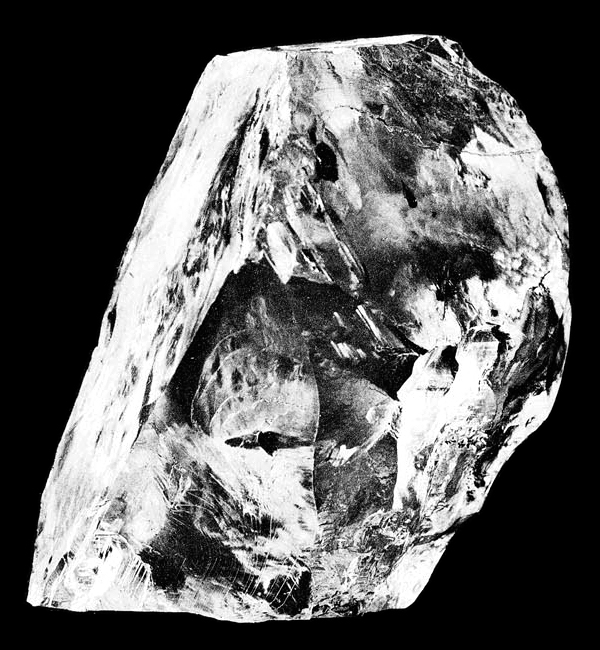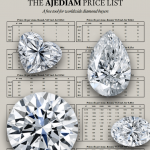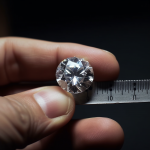Diamond Prices
Read moreThe Cullinan Diamond
The Giant King Among Diamonds
In a diamond mine in Pretoria, South Africa, the largest ever rough diamond of gem quality was found. The stone’s color, clarity, and most of all, its size, have captivated millions of spectators around the world. The diamond was gifted to the most powerful sovereign at the time, Edward VII, the king of Great Britain. Here you can read the fascinating story of this dazzling giant. Read on to find out how The Cullinan Diamond was found, transported, gifted, cut, and finally polished into one of the finest diamond collections in the world.
In this article you will find:

- Discovered in
- 26 Jan. 1905
- Country of Origin
- South Africa
- Mine of Origin
- Premier No.2 mine, near the town of Cullinan
- Carat Weight
- Original rough diamond weighed 3,106.75 carats (621.35 g)
- Cullinan I (Great Star of Africa): 530.20 carats
- Cullinan II (Lesser Star of Africa): 317.40 carats
- Cullinan III: 94.40 carats
- Cullinan IV: 63.60 carats
- Cullinan V: 18.80 carats
- Cullinan VI: 11.50 carats
- Cullinan VII: 8.80 carats
- Cullinan VIII: 6.80 carats
- Cullinan IX: 4.39 carats
- Cut Shape
- Cullinan I: Pear-shaped
- Cullinan II: Cushion-shaped brilliant
- Cullinan III: Pear-shaped
- Cullinan IV: Square-cut brilliant
- Cullinan V: Heart-shaped
- Cullinan VI: Marquise-shaped
- Cullinan VII: Marquise-shaped
- Cullinan VIII: Modified cushion shape
- Cullinan IX: Pear-shaped
- Clarity
- Potentially flawless (with small surface imperfections)
- Color
- Approximated D (colorless)
- Previous Owners
- Premier Diamond Mining Company (Thomas Cullinan)
- Transvaal government
- King Edward VII
- Asscher Diamond Company (except Cullinan I and II)
- Edward VII (Cullinan VI for Queen Alexandra)
- South African government (six remaining diamonds, gifted to Queen Mary)
- Current Owner
- Part of the private collection of Queen Elizabeth II and the British Crown Jewels
- Estimated Value
- The historical and cultural significance makes a precise value challenging to estimate. The Cullinan I and II, as part of the British Crown Jewels, are considered priceless.
The origins of the Cullinan diamond
On the 26th of January, 1905, Frederick Wells made an unusual discovery at the Premier No.2 mine. Wells’ find was located next to the town of Cullinan in South Africa, 18 feet below the surface. Inside the mine where he toiled, Mr. Wells spotted a reflection of light coming from one of the walls. He quickly scaled the wall and used his pocket knife to uncover an object that resembled a large crystal shard. The translucent fruit of his digging had a clear blue-white color, and it is reported it could have been mistaken for a piece of glass.
Mr. Cullinan inspects the stone
Mr. Wells brought the diamond to the owner of the mine, Thomas Cullinan, for inspection. What was discovered turned out to be an exceptionally clear diamond that weighed 3,106.75 carats (621.35 g) (21.9 ounces)? It was the largest diamond ever found in history! Mr. Cullinan showcased the diamond to the public at the Standard Bank of Johannesburg. Even though only 3,000 tickets were sold, an estimated 9,000 people visited the event on the 2nd of February, 1905. Experts and laymen alike were extremely eager to witness the acclaimed wonder of nature. A local newspaper, “the Transvaal Leader”, named the stone the “Cullinan Diamond”, after the owner of the mine. In their reportage, the local news outlet pioneered the idea that the diamond was so magnificent it could even be sent as a gift to King Edward VII.
A diamond for peace
It is well known that some politicians of the provisional Transvaal government liked the idea, for their relations with the British Crown had been mired by the Second Boer War. A bloody conflict that had finished only 3 years previous to the discovery. The paper’s idea was that the stone could potentially serve as a gesture of goodwill and loyalty to the Crown. The notion that the diamond could revitalize relations between the Transvaal and Buckingham palace was quite real. However, as often happens, when politics are concerned, the South African government would debate the tentative gift for almost three years.
By 1907, Afrikaans leaders Louis Botha and Jan Smuts decided to support British rule in Transvaal, as well as the purchase of the diamond. As a consequence of the resolution, the Transvaal legislative assembly passed a resolution to buy the diamond for £150,000 in August of that same year. But, their actual costs were lower due to the diamond tax laws. The owner would sell the diamond to the government, but afterward, owe 2/3rds of his profit back to the same government.
An agreement is made to gift the Cullinan
In October, the provisional government contacted the British Crown to formalize their offer. King Edward VII was initially hesitant to accept it but did so under the influence of a few historical figures, among them, Winston Churchill himself. The future prime minister played such a part in the negotiations that he was gifted a replica of the diamond for his efforts. The replica was reportedly kept on a silver platter in his home. Perhaps, it served as a reminder for all who entered his domain; a memento that symbolized Churchill’s status as a champion of the Crown.
King Edward VII accepted the Cullinan as a token of “the loyalty and attachment of the people of Transvaal, to his throne and person”. A formal promise was issued to the people of Transvaal stating the diamond would be “kept among the historical jewels and heirlooms of the Crown”. On his 66th birthday, on the 9th of November, 1907, The Sovereign Ruler officially received the rough Cullinan diamond as a gift.
The cutting of the Cullinan
Edward VII faced a significant challenge in choosing a diamond cutter who would be worthy of the task of cutting the world’s most special diamond found to date. Such an operation would require skills that only a few in the world possessed at the time. Edward’s choice ultimately fell on the Dutch Royal Asscher Diamond Company, a company recognized for patenting the Asscher Cut, as well as for polishing the 971-ct Excelsior diamond in 1903.
The Cullinan strikes back!
Joseph Asscher studied the diamond for six months before attempting to cut it. When he was ready, it took him four days to make a 1.3cm incision into the stone. After the incision was finished, Mr. Asscher struck the diamond with his knife. To everyone’s amazement, the knife broke in his hands, while the Cullinan remained unscathed. On his second attempt, the cutter split the diamond into two pieces, weighing 2029.9 and 1068.8 ct respectively, exactly as planned. There is a popular myth that Mr. Asscher was extremely nervous during this event. So flustered was he, that he reportedly fainted senseless immediately after splitting the gemstone. However, Asscher’s nephew, Louis Asscher, as well as Ian Balfour, author of the book “Famous diamonds”, dismissed the rumors as nonsense. No Asscher would faint while operating on any gem whatsoever. A bottle of champagne to celebrate was indeed a far more likely ending to the sequence of events.
Wasting no time, 3 men worked 14-hour shifts for 8 months to come. The final result of their work was nine grand gems, 96 smaller brilliants, and 9.5 carats of unpolished pieces. The pieces varied in size and shape. The Cullinan I weighed 530.20 carats, while the Cullinan IX weighed 4.39 carats. Asscher was able to present the two largest gems Cullinan I and II to King Edward VII at Windsor palace. Edward named the larger diamond “the Great Star of Africa”, yet the Cullinan name remained in popular use. For their excellent service, the Asscher company retained possession of all gems, except the Cullinan I and II, which were given to Edward VII.
The Modern Ownership History of the Cullinan Diamond
Following its discovery, the Cullinan was under the ownership of Thomas Cullinan, a South African diamond magnate. He was the owner of the Premier Diamond Mining Company, which had discovered the Cullinan.
Shipping the Cullinan from the Premier mine to London
The concerns for the safety of the diamond were so great, that an official decoy was ceremonially shipped under heavy guard. In the meantime, the real diamond was shipped through regular registered mail in an unmarked package to London. The Transvaal government succeeded in gifting the Cullinan to King Edward VII on his 66th birthday on the 9th of November. Afterward, Edward commissioned the Asscher company to cut the gemstone. As payment for their masterwork, Edward kept only the Cullinan I and II, while leaving the other gems to the Asscher Company. Yet, Edward also bought the Cullinan VI for his wife, Queen Alexandra.
The other six Cullinan diamonds were bought from the South African government. Later they gifted the gemstone to Queen Mary in memory of the Inauguration of the Union. She was Edward’s daughter-in-law, wife of George V, and a passionate collector of jewelry. They currently belong to the private collection of her granddaughter, Queen Elizabeth II. All nine Cullinan diamonds remain either in the personal possession of the Royal Family or in the British Crown Jewels. Following Edward’s death the Cullinan I and II were set into the Sovereign’s Sceptre and Imperial State Crown respectively. They remain on display in the Tower of London even today.
The technical characteristics of the Cullinan Diamond
The Cullinan I and II were set in a gold basket setting, which was impossible to remove and limited the accuracy of the color and clarity grading. However, the Cullinans were compared with other diamonds of great color and clarity. Their color grade approximated D, which means colorless. While their clarity grade is potentially flawless, which is the best possible grade, a few small surface imperfections are present on the Cullinan.
In the rough, the Cullinan weighed 3,106.75 carats (621.35 g) and measured 10.1 x 6.35 x 5.9 cm, and emanated a blue-white color.

- The Cullinan I (the Great Star of Africa) weighs 530.20 carats and is a pear-shaped diamond. It is set in the Royal Sceptre with Cross. It is on display in the London Tower.
- The Cullinan II (the Lesser Star of Africa) weighs 317.40 carats and is a cushion-shaped brilliant. It is set in the Imperial State Crown. It is on display in the London Tower.
- The Cullinan III weighs 94.40 carats and is pear-shaped. It is set in a brooch together with the Cullinan IV. The brooch is currently in the private collection of Queen Elizabeth II.
- The Cullinan IV weighs 63.60 carats and is a square-cut brilliant.
- The Cullinan V weighs 18.80 carats and is heart-shaped. It is set in a brooch, owned by Queen Elizabeth.
- The Cullinan VI weighs 11.50 carats and is marquise-shaped. It is set in an emerald and diamond necklace, that is now owned by Queen Elizabeth II.
- The Cullinan VII weighs 8.80 carats and is marquise-shaped. It is set in a pendant with the Cullinan VIII, owned by Queen Elizabeth II.
- The Cullinan VIII weighs 6.80 carats and is a modified cushion shape.
- The Cullinan IX weighs 4.39 carats and is pear-shaped. It is mounted into a ring, now owned by Queen Elizabeth II.
The Significance of the Cullinan Diamond
Up to this day, the Cullinan is the largest rough diamond of gem quality to be found. Until the polishing of the Jubilee diamond, it had also been the largest polished diamond ever. The clarity of the Cullinan I is nonetheless superior and it remains the largest clear-cut diamond in the world. The Cullinan diamond’s size, color, and clarity have inspired generations of diamond enthusiasts. The Cullinan diamond has become the cornerstone of the large diamond category. That is to say that when the size of large diamonds is discussed, our protagonist is always used as the main reference point. Without a doubt, the Cullinan is one of the most famous diamonds in the world and has a rightful place as the king of large diamonds.
We hope you enjoyed the read!
If you’d like to read about other famous diamonds like the Orlov, Eureka, or Premier Rose diamonds, you can visit Ajediam’s Famous Diamonds glossary. Or, if you’re feeling inspired, you can browse Ajediam’s premium diamond collections shop.



